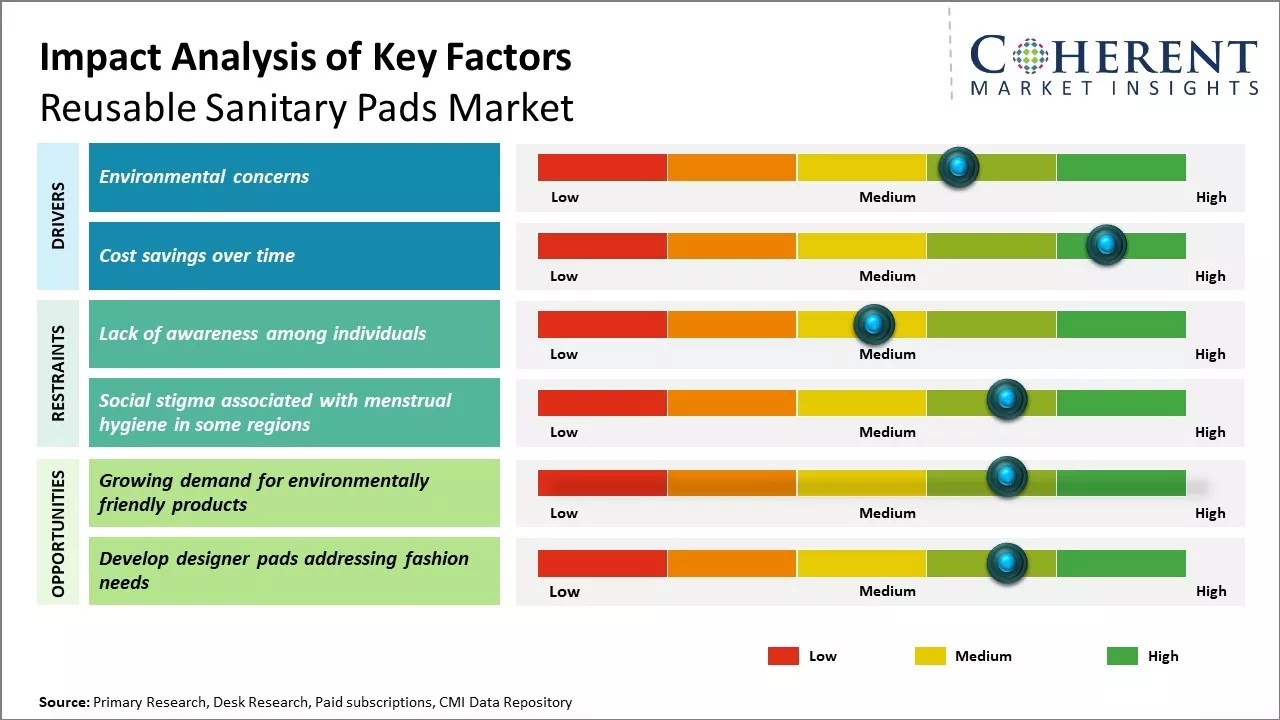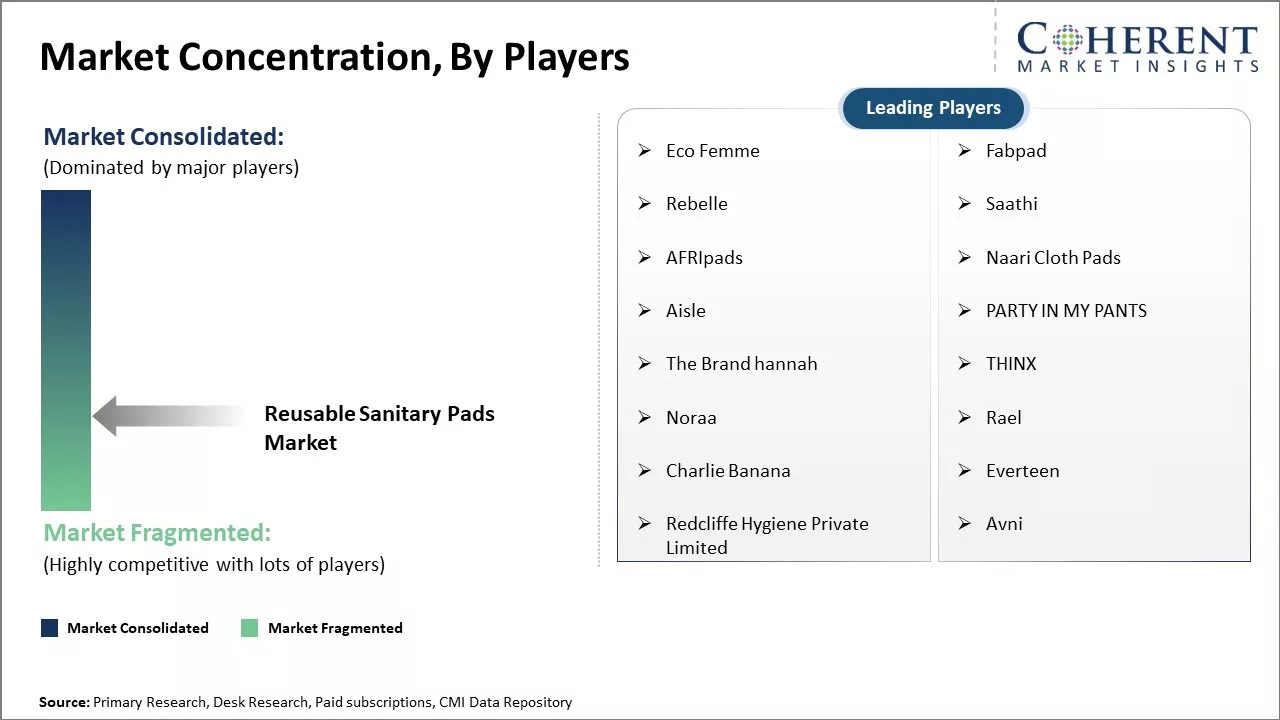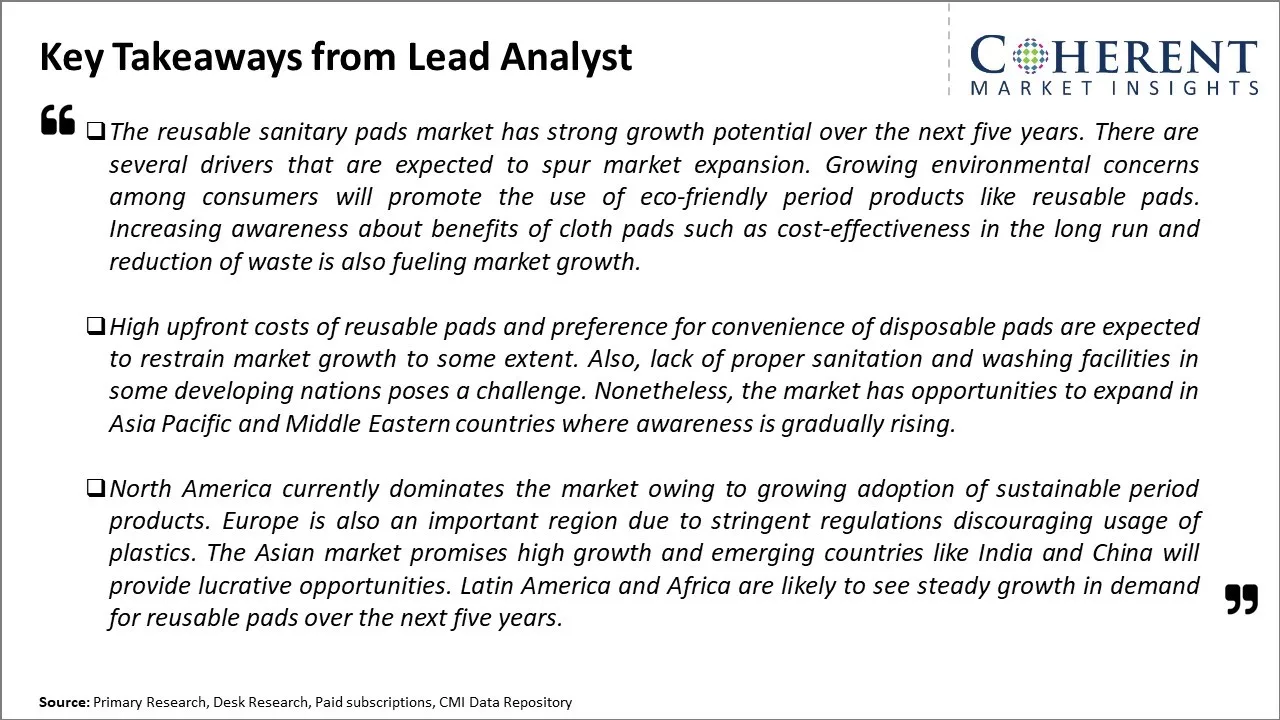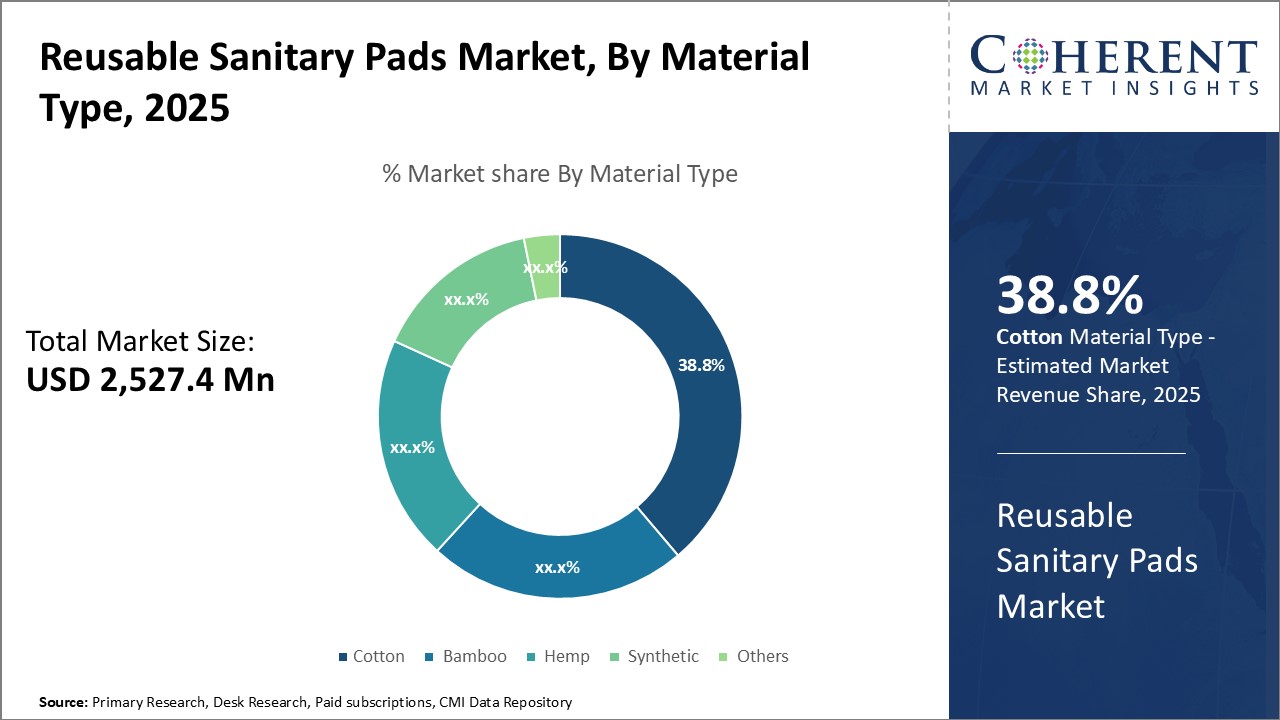Reusable Sanitary Pads Market Size and Trends
Global reusable sanitary pads market is estimated to be valued at USD 2,527.4 Mn in 2025 and is expected to reach USD 4,928.3 Mn by 2032, exhibiting a compound annual growth rate (CAGR) of 10.0% from 2025 to 2032.

Discover market dynamics shaping the industry: Download Free Sample
The market is witnessing significant growth due to increasing awareness about benefits of reusable sanitary pads and growing focus towards sustainability. Reusable sanitary pads are more eco-friendly as compared to disposable ones which creates huge amount of non-biodegradable waste. Various government initiatives to promote reusable period products and availability of improved products with breathable fabrics are driving the sales of reusable sanitary pads. However, preference for disposable pads in developing nations and availability of cheaper substitutes may hinder the market growth to some extent during the forecast period.
Environmental concerns
There is a growing awareness about the environmental impact of various disposable products. Sanitary pads are mostly made of plastics and other non-biodegradable materials that take a very long time to decompose. When disposed of after every use, these contribute significantly to environmental pollution and waste clogging landfills and water bodies. Many consumers, especially younger demographic, are more sensitive about choosing products that have lower carbon footprint. Reusable pads provide an eco-friendly solution as these can be reused multiple times and eventually laundered. Made with organic cotton or bamboo fabric, these are completely natural and biodegradable. Using reusable pads for a few years can help eliminate hundreds of disposable pads from ending up in waste streams. As sustainability becomes an increasingly important decision-making factor, many consumers would switch to reusable pads just for their environmental benefits. Various environmental organizations and influencers are also promoting reusable hygiene products.
Market Concentration and Competitive Landscape

Get actionable strategies to beat competition: Download Free Sample
Cost savings over timeWhile reusable pads have higher upfront cost than disposables, these prove economical in the long run. A small set of good quality, toxin-free cloth pads can last for several years with proper care and maintenance. Considering an average woman uses 10,000-16,000 disposable pads in her lifetime, reusable pads compensate their initial investment within 1-2 years. After the break-even point, these only require occasional fabric replacement or purchase of extras which brings down the annual cost. Especially for women in their reproductive age group, reusable pads work out much cheaper than disposables bought every month. Many cash-strapped students and budget shoppers have opted for reusable period products because of their pay-as-you-go pricing. Reusable pads being affordable in the long-run also addresses environmental and health concerns of today's informed consumers.

To learn more about this report, Download Free Sample
Market Challenges – Lack of awareness among individualsOne of the key challenges faced by the reusable sanitary pads market is lack of awareness. Many women remain unaware of reusable pads as an eco-friendly and cost-effective alternative. Further, outdated notions of stigma and taboo around menstruation in certain cultures restrict the market growth. High initial costs of pads also discourage some consumers. Retail availability of reusable pads is limited compared to disposables, hampering widespread adoption. Effective marketing campaigns are needed to tackle misconceptions and educate the potential market.
Market Opportunities – Growing demand for environmentally friendly products
The reusable sanitary pads market witness considerable opportunities owing to rising awareness about sustainable period care. Many women are switching to more environmentally products to reduce waste. Increasing support from NGOs and women empowerment platforms promotes reusable pads. The biodegradable material and cost savings over time provide a compelling value proposition. With e-commerce growth, accessibility issues are reducing, thus, creating lucrative opportunities for market development over the projected period.

Discover high revenue pocket segments and roadmap to it: Download Free Sample
Insights, By Material Type: Cotton dominates the material type segment due to its absorbency and comfortMaterial segment is sub-segmented into cotton, bamboo, hemp, synthetic, and others. Cotton segment is estimated to hold 38.8% share of the market in 2025. Made from a natural fiber, cotton pads are highly absorbent and soft against the skin. Women prefer cotton over other materials as it effectively absorbs menstrual fluids without any leakage. Its absorbency allows cotton pads to be worn for longer durations with complete protection and comfort. Being a natural fiber, cotton is breathable and avoids moisture retention. This keeps the skin dry and rash-free even during prolonged use. The soft texture of cotton prevents irritation in the sensitive areas. Many women experience allergies or skin issues with synthetic materials, but cotton poses no such risks. Its hypoallergenic properties make cotton pads suitable for all skin types. Moreover, cotton is known for its breathability. The tiny pores and capillaries in cotton fibers allow air to circulate well below the pad. This avoids dampness, odors and the probability of infections in the genital area. With good ventilation, cotton pads can be worn for many hours without causing discomfort.
Insights, By Distribution Channel: Buying convenience drives hypermarket and supermarket segment growth
Distribution Channel segment is sub-segmented into pharmacy stores, hypermarket and supermarket, e-commerce, general stores, and others. The hypermarket and supermarket segment is anticipated to hold 34.6% of the market share in 2025. Women prefer buying pads from these stores due to the availability of a wide variety under one roof. Hypermarkets stock different brands and a large assortment of sizes, absorbencies and material types. This allows customers to examine, compare and choose the best-suited products. The ‘one-stop-shop’ concept of hypermarkets makes purchasing pads convenient without running to multiple outlets. Women can club pad shopping along with their regular grocery trips to hypermarkets. This blending of utility and impulse buying propels sales through these channels. Moreover, hypermarkets deploy effective promotional strategies to push pad sales. From attractive shelf displays and offers to social media campaigns, these create ongoing awareness about reusable pads and boost trial. The large retail space and prominent locations within hypermarkets provides pads high visibility and accessibility for buyers.
Regional Insights

Need a Different Region or Segment? Download Free Sample
North America has emerged as the dominant regional market for reusable sanitary pads and is anticipated to hold 37.9% of the market share in 2025. The U.S., in particular, is at the forefront with leading players establishing robust supply chains to cater to demand from major cities as well as small towns. Reusable pads are highly accepted in modern retail channels like supermarkets and pharmacies, giving them an edge over conventional disposable pads. In terms of exports, North American companies are actively promoting their brands in Latin American and Western European countries by partnering with local distributors. However, the pricing of reusable pads is on the higher side in the region as compared to Asia due to stringent manufacturing standards and use of organic cotton materials, limiting mass adoption.
The Asia Pacific region is envisioned to exhibit the fastest growth in the reusable sanitary pads market over the forecast period. Countries like India and China are prime locations for both domestic consumption as well as exports. The availability of low-cost manufacturing hubs and raw material suppliers has enabled Southeast Asian countries especially Vietnam and Indonesia to emerge as key exporters. While China dominates imports to developed markets, India caters majorly to neighboring South Asian countries. The acceptance of reusable pads is rapidly increasing in tier-2 and tier-3 cities of India led by dedicated advocacy groups emphasizing the need for sustainable menstrual hygiene solutions.
Market Report Scope
Reusable Sanitary Pads Market Report Coverage
| Report Coverage | Details | ||
|---|---|---|---|
| Base Year: | 2024 | Market Size in 2025: | USD 2,527.4 Mn |
| Historical Data for: | 2020 To 2024 | Forecast Period: | 2025 To 2032 |
| Forecast Period 2025 to 2032 CAGR: | 10.0% | 2032 Value Projection: | USD 4,928.3 Mn |
| Geographies covered: |
|
||
| Segments covered: |
|
||
| Companies covered: |
Eco Femme, Fabpad, Rebelle, Saathi, AFRIpads, Naari Cloth Pads, Aisle, PARTY IN MY PANTS, The Brand hannah, THINX, Noraa, Rael, Charlie Banana, Everteen, Redcliffe Hygiene Private Limited, Avni |
||
| Growth Drivers: |
|
||
| Restraints & Challenges: |
|
||
Uncover macros and micros vetted on 75+ parameters: Get instant access to report
Reusable Sanitary Pads Industry News
- On March 06, 2024, The State Rural Livelihood Mission (SRLM) announced that it will begin providing reusable pads made of banana fiber at its Aajeevika Mart in Bhopal Haat in June 2024. Users have said that the eco-friendly sanitary napkins helped to alleviate menstruation cramps, heavy blood flow, rashes, and odor.
- In January 2022, RUBiS Energy Kenya, a pan African downstream oil company funded the GirlsRun marathon, a menstrual hygiene project, in collaboration with Women Development Centre (WODEC) and Kenya Community Sports Foundation (KESOFO). This was in preparation for the GirlsRun Marathon, which took place in October 2022. The GirlsRun project aims to help the Women Development Centre's (WODEC) Menstrual Hygiene Management (MHM) program, which supports girls throughout this time of life and makes reusable sanitary pad kits locally.
- In September 2021, LastObject, an eco-startup for reusable materials, enetered the feminine hygiene industry with its newest product, LastPad, a reusable sanitary pad designed to lessen the environmental effect of period products while also providing women with a more inexpensive, pleasant, and healthful alternative
*Definition: Reusable sanitary pads market consists of companies that manufacture and sell reusable cloth pads that can be washed and reused during a woman's menstrual cycle. These reusable pads are made of materials like organic cotton, bamboo, or microfiber and provide an eco-friendly and cost-effective alternative to disposable pads. The reusable pads absorb menstrual blood and other vaginal discharge. These are designed for comfort and can be easily hand washed or machine washed and reused for years, making them a more sustainable option compared to disposable sanitary pads.
Market Segmentation
- Material Type Insights (Revenue, USD Mn, 2020 - 2032)
- Cotton
- Bamboo
- Hemp
- Synthetic
- Others
- Distribution Channel Insights (Revenue, USD Mn, 2020 - 2032)
- Pharmacy Stores
- Hypermarket and Supermarket
- E-commerce
- General Stores
- Others
- Regional Insights (Revenue, USD Mn, 2020 - 2032)
- North America
- U.S.
- Canada
- Latin America
- Brazil
- Argentina
- Mexico
- Rest of Latin America
- Europe
- Germany
- U.K.
- Spain
- France
- Italy
- Russia
- Rest of Europe
- Asia Pacific
- China
- India
- Japan
- Australia
- South Korea
- ASEAN
- Rest of Asia Pacific
- Middle East
- GCC
- Israel
- Rest of Middle East
- Africa
- South Africa
- North Africa
- Central Africa
- North America
- Key Players Insights
- Eco Femme
- Fabpad
- Rebelle
- Saathi
- AFRIpads
- Naari Cloth Pads
- Aisle
- PARTY IN MY PANTS
- The Brand hannah
- THINX
- Noraa
- Rael
- Charlie Banana
- Everteen
- Redcliffe Hygiene Private Limited
- Avni
Share
Share
About Author
Manisha Vibhute is a consultant with over 5 years of experience in market research and consulting. With a strong understanding of market dynamics, Manisha assists clients in developing effective market access strategies. She helps medical device companies navigate pricing, reimbursement, and regulatory pathways to ensure successful product launches.
Missing comfort of reading report in your local language? Find your preferred language :
Transform your Strategy with Exclusive Trending Reports :
Frequently Asked Questions
EXISTING CLIENTELE
Joining thousands of companies around the world committed to making the Excellent Business Solutions.
View All Our Clients
